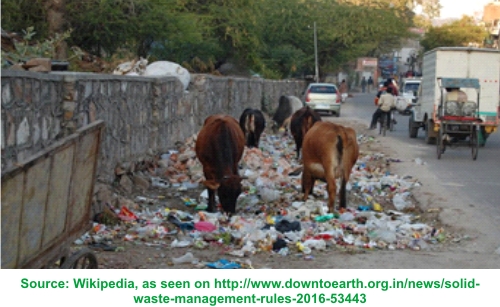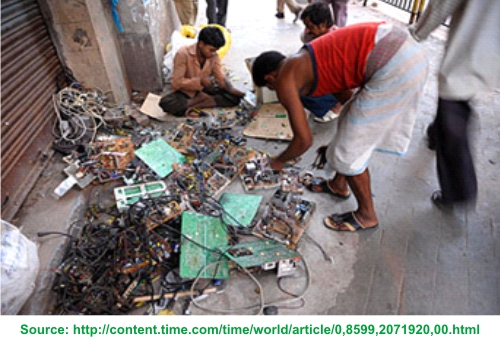|
How Conducive is India’s
National Policy With growing prosperity in the country, 62 million tonnes of garbage is generated annually by 377 million people living in urban India. We are the world’s third-largest garbage generators. It is a disturbing fact that only 43 million tonnes per annum of waste is collected, 11.9 million is treated and 31 million is dumped in unscientific landfill sites, implying that 75-80% of the municipal solid waste gets collected and barely 22-28 % of this waste is recycled or treated (Press Information Bureau, 2016). Recent incidents such as rampant self-ignition of unregulated dump sites in Delhi indicate the lethal social and environmental hazards awaiting India’s cities and towns.
It is also estimated that the Urban Local
Bodies spend about Rs. 500 to Rs. 1500 on a tonne of solid waste for
collection, transportation, treatment and disposal. About 60-70 per cent
of this amount is spent on street sweeping of waste, 20 to 30 per cent
on transportation and less than 5 per cent on final disposal of waste,
which shows that hardly any attention is given to scientific and safe
disposal. With such information coming to one’s notice, it is rather
easy to conclude that waste management priorities in our country are set
unwisely, further debilitated by financial and institutional
constraints.
India’s fundamental step to tackle this issue was issuing laws and guidelines for governing waste management in the country. The Municipal Solid Waste (Management and Handling) Rules, 2000 were the primary step in the direction. The said rules were amended after 16 years, with an updated set of rules called the Solid Waste Management Rules, 2016. Considering the diverse categories of wastes being generated as a consequence of improved lifestyles, the Ministry of Environment, Forest and Climate Change has also amended and released targeted rules for management of: • Plastic Waste (Plastic Waste Management Rules, 2016) • Biomedical Waste (Biomedical Waste Management and Handling Rules, 2016) • Hazardous Waste (Hazardous Waste Management Rules 2016) • E-Waste (E-Waste Management Rules, 2016) • Construction and Demolition Waste (Construction and Demolition Waste Management Rules, 2016) The new set of rules draw from a scientific and international influence, to include tested approaches for efficacious waste management. Some of the highlights are as follows: • Household segregation of municipal solid waste: It aids recovery of recyclable material by separating wet waste from dry waste. The rules lay immense emphasis on practices such as home-composting, separating recyclables like paper and reduction in the use of plastic packaging. • User fees for collection: The Municipal Local Bodies have been given the authority to decide the user fees for providing waste management facilities, including door-to-door collection, sweeping, transportation etc. • Collection mechanism for non-biodegradable packaging material: Making corporates accountable for waste generated by their product packaging. • Promotion of waste to energy: Albeit debatable in the Indian context, the approach is acceptable and functional in some European countries. • Extended Producer Responsibility (EPR) for lead acid batteries and e-waste: Electronic items occupy space in disposal sites, contain toxic elements, and treatment and recovery of useful components from multiple types of these goods is a limitation for the Municipality. It is thus just and fair that manufacturers set up technological facilities in association with recyclers, for recovery, treatment and proper disposal of electronic waste. Japan is a remarkable example of noteworthy EPR implementation. • Waste hierarchy: The Solid Waste Management Rules, 2016 aim to address the complex issue with the principal of ‘waste hierarchy’, which means the priority order in which solid waste is to be managed is by giving emphasis to prevention, reduction, reuse, recycling, recovery and disposal. This priority order also entails prevention as the most preferred option and disposal at the landfill being the least preferred one.
Despite stringent rules and guidelines,
there are multiple loopholes and roadblocks to efficient waste
management in India. The rules don’t penalise absence of waste
segregation at source, which is entirely absent even in the relatively
developed metropolitan areas of the country. The rules also fail to
incentivise implementation.
The E-waste Management Rules, 2016 recommend retroactive action for collection of goods sold by electronic companies. This necessitates collection and recycling of products sold nearly 9-10 years ago, depending on the varying end-of-life spans specified for the products in the said rules. The biggest challenge in implementation here would be the ability to track products sold in the past, owing to absence of proper customer records and the inevitable competition by the informal sector. A secondary challenge involves costs required to set up recycling facilities and the overheads, since the customers were never charged a recycling fee on the sale of the product. The inadequacy of the legal mechanism is also reflected via exclusion of a host of essential principles of proper waste management, vis-à-vis: • Insufficient focus on decentralised waste management systems: In densely populated urban areas of the country, collection and transportation of waste are major financial burdens. Decentralised systems focusing on community composting and recycling have not been mandated or incentivised. • Exclusion of the informal sector: Deriving from absence of a focus on decentralised systems, the informal sector has also been totally ignored while planning. The major market and potential for recycling lies within the informal sector in the country, which also thus becomes a competitor to initiatives like EPR. It was only possible to effectively roll-out household paper collection for recycling in Indian cities, because it was incentivised and decentralised by inclusion of local raddiwallahs. Another major contradiction within the rules is the emphasis on Waste to Energy plants which are considered fundamental for the functioning of modern centralised waste management systems. A less harmful use of such technologies in developed countries is facilitated by sophisticated technology and machinery, stringent standards for pollution control, effective monitoring and regulation, penalisation for non-compliance and an additional benefit - heat recovery for cold countries. These incineration based waste to energy plants have a greater output in terms of heat energy than electrical energy, which is absolutely inessential for a tropical country like India. Moreover, domestic waste streams in India have low heat and high moisture content, making them unfit for burning to obtain energy. Considering the current national situation, air pollution levels would be aggravated further if we allow waste to energy/ incineration plants to come up in the country. A regulated, decentralised system for waste management, involving communities and the informal sector, is India’s best bet to overcome the challenge. The current system with its inadequacies is definitely not sustainable. ■
Kavya Arora
References:
|

